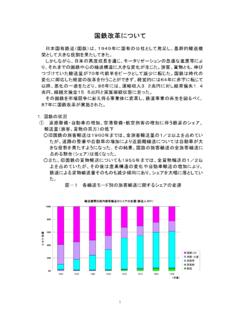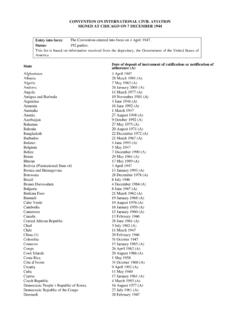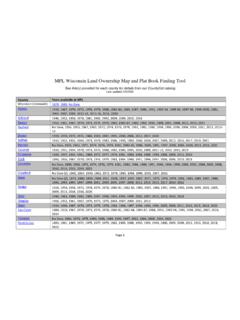Transcription of Implications of Population Aging for Economic Growth
1 NBER WORKING PAPER SERIESIMPLICATIONS OF Population Aging FOR Economic GROWTHD avid E. BloomDavid CanningG nther FinkWorking Paper 16705 BUREAU OF Economic RESEARCH1050 Massachusetts AvenueCambridge, MA 02138 January 2011 Support for this work was provided by the Program on the Global Demography of Aging at HarvardUniversity, funded by Award Number P30AG024409 from the National Institute on Aging . The contentis solely the responsibility of the authors and does not necessarily represent the official views of theNational Institute on Aging or the National Institutes of Health. The authors thank Marija Ozolinsand Larry Rosenberg for their assistance in the preparation of this paper. The views expressed hereinare those of the authors and do not necessarily reflect the views of the National Bureau of working papers are circulated for discussion and comment purposes.
2 They have not been peer-reviewed or been subject to the review by the NBER Board of Directors that accompanies officialNBER publications. 2011 by David E. Bloom, David Canning, and G nther Fink. All rights reserved. Short sectionsof text, not to exceed two paragraphs, may be quoted without explicit permission provided that fullcredit, including notice, is given to the of Population Aging for Economic GrowthDavid E. Bloom, David Canning, and G nther FinkNBER Working Paper No. 16705 January 2011 JEL No. J14,J15,J21,J26,O1,O4 ABSTRACTThe share of the Population aged 60 and over is projected to increase in nearly every country in theworld during 2005-2050. Population ageing will tend to lower both labor-force participation and savingsrates, thereby raising concerns about a future slowing of Economic Growth .
3 Our calculations suggestthat OECD countries are likely to see modest but not catastrophic declines in the rate of economicgrowth. However, behavioral responses (including greater female labor force participation) and policyreforms (including an increase in the legal age of retirement) can mitigate the Economic consequencesof an older Population . In most non-OECD countries, declining fertility rates will cause labor-force-to-populationratios to rise as the shrinking share of young people will more than offset the skewing of adults towardthe older ages. These factors suggest that Population ageing will not significantly impede the paceof Economic Growth in developing E. BloomHarvard School of Public HealthDepartment of Global Health and Population665 Huntington , MA 02115and CanningHarvard School of Public HealthDepartment of Global Health and Population665 Huntington , MA nther FinkHarvard School of Public HealthDepartment of Global Health and Population665 Huntington , MA Population Aging and Economic Growth David E.
4 Bloom, David Canning, and G nther Fink I. Introduction The world is entering largely unfamiliar territory with respect to Population Aging . Combined with the dynamic evolution of past variations in birth and death rates, recent declines in fertility rates and increases in life expectancy are causing a significant shift in the global age structure. The number of people over the age of 60 is projected to reach 1 billion by 2020 and almost 2 billion by 2050, representing 22 percent of the world s Population . The proportion of individuals aged 80 or over is projected to rise from 1 percent to 4 percent of the global Population between today and The elderly are not only growing rapidly in absolute numbers, but have also become substantially healthier.
5 In a phenomenon referred to by demographers and health specialists as the compression of morbidity , the length of healthy old-age appears to be increasing. Part of this trend can be attributed to increases in the length of life, and part to shorter and later periods of illness. The net effect is an increase in number of years lived at old age without major health problems. Since different age groups have different needs and productive capacities, a country's Economic characteristics will likely change as its Population ages. A standard approach to assessing these changes is to assume constant age-specific behavior with respect to employment, consumption, and savings, and to assess the Implications of changes in the relative size of different age groups for these fundamental contributors to national income.
6 However, this simple approach is likely to be misleading as changing norms and expectations are likely to alter individual behavior in a way that will influence the Economic consequences of Aging . In particular, expectations of living longer than previous generations may induce individuals to remain in the workforce for longer and to begin to draw down savings at a later age. In addition, the links between Population Aging and macroeconomic performance are mediated by the institutional context. With increasing longevity and Aging populations, retirement policy, pension and health care finance, the efficiency of labor and capital markets, and the structure of regional and global Economic systems are likely to adjust.
7 The magnitude of these shifts may in turn depend on voting and other political behavior of an Aging electorate whose needs and interests may differ from those of younger people. This paper examines the effects of Population Aging on Economic Growth . We begin with a presentation and analysis of descriptive statistics on the extent and pace of Population Aging . The paper then explores the overall effect of Population Aging on Economic Growth as well as the effects operating via two main channels through which Growth can occur: labor supply and human capital accumulation. Accounting effects of Population Aging on factor accumulation and Economic Growth are distinguished from behavioral effects. Finally, the paper highlights the 1 The United Nations makes several separate forecasts of Population size, including ones based on low-, medium-, and high-fertility assumptions.
8 This paper uses the UN's medium-fertility scenario except where otherwise stated. 2 important role played by the policy and institutional environment in determining the Economic Growth effects of Population Aging . This section also discusses a variety of demographic, behavioral, and policy forces crucial to understanding and guiding the effect of Population Aging on Economic Growth . II. Population Aging : Facts, Force, and Future In this section, we present a series of key facts regarding past and projected future Population Aging , and briefly consider some of the related policy Implications . The data and figures presented will serve as anchors for the Economic analyses found in subsequent sections. We first look at the overall UN Population projections, and then examine the factors underlying the rise in the absolute size and share of the elderly Population .
9 We also briefly investigate how Population trends will affect the options faced by policymakers. Population data and projections Population projections from the United Nations change every two years as new estimates are published. For example, forecasts of the total world Population in 2050 declined from about 10 to 9 billion people between 1994 and 2008. One might expect projections of the number of people aged 60 or above and 80 or above to be rather stable, since all those who will reach those ages in the next six decades have already been born and unpredictable changes in fertility need not be taken into account. However, these projections have changed significantly, even in recent years: the greatest proportionate change between the 1994 and 2008 UN forecasts occurred for the Population aged 80+ in 2050, with a 20% increase in the Population size estimate for developed countries since 1994.
10 The Population projection data displayed in this paper should thus be interpreted with caution as current estimates may well be significantly altered as new fertility and mortality data become available. 3 Despite these concerns around long-term projections, a simple look at today s age structure makes it very clear that world is experiencing an unprecedented phenomenon in terms of The 60+ and 80+ age groups shares of the total Population are higher than at any time in history, and their Growth is accelerating. The global Population aged 60 and over has increased from 200 million in 1950 to around 760 million today. By 2050, it is projected to reach 2 billion (see Exhibit 1). The number aged 80+ has risen from 14 million in 1950 to around 11 million today, and will be near 400 million by 2050 if current projections prevail.














